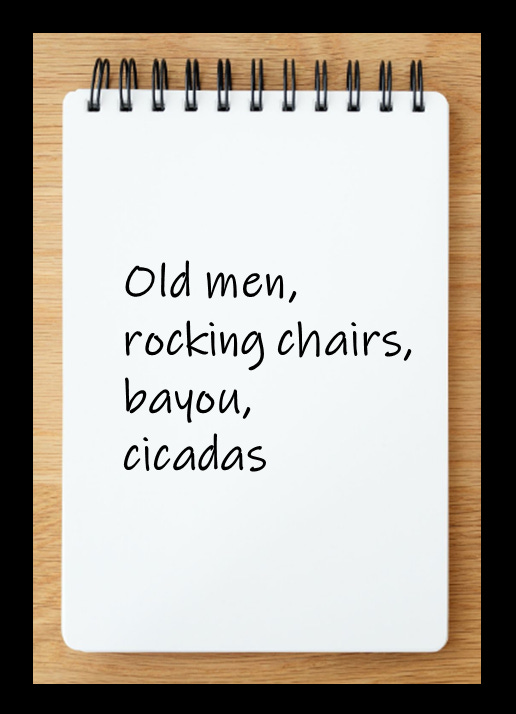Creating A Character
Issue #44, Putting Meat on the Bones 1
(This is the first in a five-part series, leading writers through the stages from ideas to drafting to a finished, published tale.)
Let’s take parts I’ve introduced in this newsletter and assemble the bones of a fictional character. I’ll start with the real-life character(s) from which my original idea came, then over the next few issues, show how I brought my central fictional character and his story to life.
As a teenager I was already writing fiction—and already using people-watching as part of it, as discussed in Writing Rhythm Issue #3. Then, the summer I turned 17, our family drove from the west coast to Florida to attend my great-grandmother’s funeral.
Somewhere in Louisiana, Mississippi or Alabama we stopped at a combined general store/gas station with a covered porch in front. On the wooden deck at one end were posed three rocking chairs; in each sat an old man. Every one of them tilted slowly back and forth, all staring down at…something. As I walked across the porch to access the door, I saw that the men contemplated the greenery and sluggish black waters of a bayou running by the porch. The air was hot and sticky and all you could hear was the clicking and buzzing of cicadas.
(Here's a picture I found online, as I often do, to aid in my process.)
No story leapt into mind, but I wanted to remember everything about this scene and those men. My idea file at the time was in the form of a small notepad. Idea files are explained in Writing Rhythm Issues 4-6.
Once back in the car, I took that notepad and simply jotted down six words: old men, rocking chairs, bayou, cicadas. Again, these descriptors reflected no story, only a reminder of what struck me at the time as a scene with power and potential.
The memory fermented for years (a concept discussed in Writing Rhythm Issue #15).
Every now and then I go “back to the well,” and read over my observations and snippets of dialogue from my idea file. And after a long time I started to dream up more about those three older guys on their rockers. That was when I officially opened up a backstory file (see Writing Rhythm Issues #36-39).
In Writing Rhythm Issue #40, I recommended starting out with a brief backstory to which I would add, over time. Now that I was invested in turning this scene into something more, I went from:
…to this original backstory paragraph:
Two sentences: that was all I had, at first (and all I recommend that you start with). It’s a length over which even an inveterate—or committed—Pantser couldn’t quibble (see Writing Rhythm Issue #12). In those short two sentences, you can see where I had already inserted fictional elements around the facts. Here they are again with a few notes.
[Much of this reflects how that bayou affected me, which is setting, of course, to be covered in the future. But there’s no way to omit it here because in this case setting was so inseparable from character.]
This leads us to…
Q: Okay, so I made up a character I like, and wrote a short backstory. How do I develop a story from that character?
A: Go back and look at Writing Rhythm Issue #42 to remind yourself of the three ingredients of story, then:
Study What You Have—And Add to It
Look carefully at all elements from your backstory and see where they might be leading you. Then start brainstorming. Add whatever you want or need to work your way towards a story. Subtract elements that wouldn’t be a part of this tale.
Note that there’s no plot in my example yet, just a backstory with emerging details and a general direction. Those bones will have to stay bare for now. But never fear. As a writer long-established in my habits, you can count on me to flesh them out next time.
(Hint, hint.)
What is inveterate?
Action Plan
Come to craigstrickland.net to contact me, read my fiction, and see what’s upcoming…
Next Up
#45) Mining the Backstory, Putting Meat on the Bones 2. See you in two weeks!
Craig


















You have to be clever to write a backstory. Of course you have to be clever to write any story
: )